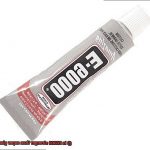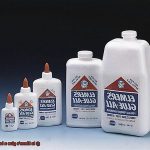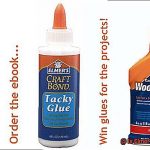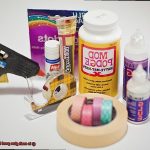Are you tired of struggling with adhesives that just won’t stick to your EVA foam creations? Have you tried every glue out there, from hot glue to super glue, but nothing seems to work? Well, fear not my fellow cosplayers and crafters, because we have found the ultimate solution: e6000 adhesive.
This industrial-strength adhesive has become increasingly popular among the cosplay community for a good reason. It’s strong, durable, and can withstand extreme temperatures, making it perfect for projects that will be exposed to the elements. Plus, its clear drying formula makes it ideal for intricate designs and details.
One of the best things about e6000 adhesive is its flexibility. Unlike other glues that can become brittle over time and cause your project to fall apart, this rubber-like adhesive bonds materials without cracking or breaking down. This means that your EVA foam projects will last longer and won’t disappoint after only a few wears.
However, it’s essential to use e6000 in a well-ventilated area as it can have a potent odor. Additionally, avoid using it on foam containing plasticizers as it may cause the material to break down.
In conclusion, e6000 adhesive is an excellent option for bonding EVA foam due to its strength, durability, and flexibility. So next time you’re working on an EVA foam project, don’t hesitate to give this wonder glue a try. Trust us; you won’t regret it.

Advantages of Using e6000 on EVA Foam
Contents
- 1 Advantages of Using e6000 on EVA Foam
- 2 Disadvantages of Using e6000 on EVA Foam
- 3 How to Apply e6000 to EVA Foam
- 4 Tips for Working with e6000 on EVA Foam
- 5 Different Types of Adhesives Suitable for EVA Foam
- 6 Pros and Cons of Using Other Adhesives on EVA Foam
- 7 Pre-Treatment Tips for Working with EVA Foam and Adhesives
- 8 Common Mistakes When Working With EVA Foam and Adhesives
- 9 Conclusion
This popular adhesive is a crafter’s best friend, providing a strong and versatile bond that can withstand heavy use and wear.
One of the biggest advantages of e6000 on EVA foam is its strong bonding capabilities. It creates a permanent bond that will last through multiple uses, making it perfect for cosplay costumes, props, footwear, and workout mats. Say goodbye to flimsy foam projects and hello to lasting durability.
Flexibility is another key advantage of e6000. Unlike other adhesives that become brittle or hard when dry, e6000 remains flexible. This is especially important for projects that require movement and flexibility, like yoga mats or foam armor for cosplay costumes. With e6000, your projects will move with you, not against you.
Clear drying properties make e6000 ideal for projects where the adhesive may be visible. It dries clear and won’t leave any unsightly marks or discoloration on your foam projects. Plus, it’s easy to apply and dries quickly, saving you time during the crafting process.
E6000 is also waterproof and heat-resistant, making it perfect for outdoor projects like pool toys or outdoor cushions. It can withstand exposure to water, sun, and heat without losing its bonding capabilities. With e6000, your foam projects can brave the elements without falling apart.
It’s important to note that e6000 has a strong odor, so be sure to use it in a well-ventilated area and wear a mask if you’re sensitive to fumes. Additionally, it can take up to 24 hours to fully cure, so plan accordingly when working on time-sensitive projects.
Disadvantages of Using e6000 on EVA Foam
While this adhesive is known for its strong bonding capabilities, it’s important to note that there are some potential disadvantages that may come with this choice.
Firstly, one of the most significant drawbacks of using e6000 on EVA foam is the slow drying time. Waiting for the glue to fully set can be time-consuming and frustrating, especially if you’re working with a tight deadline. To make matters worse, the foam can slide around before the glue has dried, leading to a messy and uneven application.
Another challenge is cleaning up excess glue. When e6000 dries, it hardens into a rubbery consistency that can be challenging to remove. This can be particularly troublesome if the foam will be visible in the final product.
It’s also worth noting that e6000 emits strong fumes during the drying process. If you don’t use it in a well-ventilated area, these fumes can be harmful to people with respiratory issues or those who are sensitive to strong odors.
Lastly, while e6000 is generally a strong adhesive, it may not be the best choice for projects that require flexibility in the foam. Over time, the glue can become brittle and crack if the foam is bent or flexed too much.
How to Apply e6000 to EVA Foam
EVA foam is a popular material in the crafting world due to its lightweight and durable nature. However, finding the right adhesive to bond EVA foam pieces together can be a challenge. Enter e6000, a flexible and strong adhesive that can provide a reliable hold if applied correctly.
Before applying e6000 to EVA foam, it’s crucial to ensure that the surface is clean and dry. Any dirt or debris can weaken the bond, so take the time to wipe down the foam with rubbing alcohol and a clean cloth.
To apply the adhesive, use a small brush or toothpick to spread a thin layer onto the surface of the foam. Avoid using too much glue as it can spread out and potentially damage the foam. A little goes a long way with e6000.
Once the adhesive is applied, press the two surfaces together firmly and hold them in place for several minutes. Do not move or disturb the foam during this time, as it can cause the adhesive to shift and weaken the bond.
After allowing ample drying time of 24-72 hours, your EVA foam project should have a strong and durable bond. However, it’s still important to handle your project with care and avoid subjecting it to excessive stress or strain.
Tips for Working with e6000 on EVA Foam
When it comes to working with e6000 on EVA foam, there are several tips and tricks that can help you achieve a successful outcome. Here are some key tips to keep in mind:
Clean surfaces
Before applying the glue, it’s important to ensure that both surfaces are clean and free of any debris or oils. You can use rubbing alcohol or a similar cleaning agent to wipe them down.

Thin, even layers
Applying e6000 in thin, even layers will help prevent excess glue from seeping out and creating a messy and uneven bond. You can use a toothpick or small brush to apply the glue precisely.
Allow proper drying time
It’s essential to let the glue dry completely before handling or moving the foam piece. This can take up to 24 hours, depending on the size and weight of the project.
Avoid heat sources
Keep the glue away from heat sources as this can cause it to dry out and lose its effectiveness. Store it in a cool, dry place with the lid tightly closed when not in use.
Use clamps or weights
For larger or heavier pieces of foam, use clamps or weights to hold them in place while the glue dries. This will ensure a strong and durable bond.
Remove excess glue
If any excess glue gets on the foam, don’t panic. Simply dip a cotton swab in rubbing alcohol and gently rub the affected area until the glue dissolves.
Different Types of Adhesives Suitable for EVA Foam
EVA foam is a versatile material that is widely used in various applications, ranging from cosplay costumes to children’s play mats. However, bonding EVA foam can be a daunting task, given the challenges of finding the right adhesive. In this blog post, we explore the different types of adhesives that are suitable for bonding EVA foam, each with its unique strengths and weaknesses.
Contact Cement
Contact cement is a popular choice for many professionals and DIY enthusiasts. This adhesive requires both surfaces to be coated with the adhesive and allowed to dry before being pressed together. Contact cement creates a strong and durable bond that can withstand heavy use. It is also heat-resistant and waterproof, making it ideal for applications such as shoe soles or boat flooring.
Super Glue
Super glue, also known as cyanoacrylate glue, works by creating a chemical reaction when it comes into contact with moisture, causing it to harden quickly. This makes it suitable for small projects or repairs that require a quick fix. However, super glue may not be ideal for larger projects or items that will be subjected to heavy use.
Hot Glue
Hot glue is another popular adhesive for EVA foam, particularly for new crafters. It is easy to work with and sets quickly, making it perfect for small projects or repairs. However, hot glue may not be the best option for larger projects or items that require a strong, long-lasting bond. It is also not suitable for high-temperature environments.
E6000
E6000 is an industrial-strength glue that creates a flexible, waterproof bond ideal for a range of applications, including cosplay costumes, props, and accessories. However, some debate whether e6000 is suitable for all types of EVA foam. Some users have reported that e6000 can melt or break down certain varieties of EVA foam if not used correctly.

Specialty Adhesives
There are also specialty adhesives designed specifically for use with EVA foam. These adhesives are often marketed as “foam-safe” and formulated to create a strong bond without damaging the foam.
Some examples include Aleene’s Original Tacky Glue and 3M Super 77 Multipurpose Adhesive. When choosing an adhesive, it is crucial to consider the specific needs of the project and do some research on the best options available.
Pros and Cons of Using Other Adhesives on EVA Foam

While e6000 is a popular choice, there are other adhesives available that may work better depending on the project’s specific needs and requirements. Here are some of the pros and cons of using other adhesives on EVA foam.
Contact cement is a popular adhesive that creates a strong, permanent bond and dries quickly. It’s also waterproof and heat-resistant, making it ideal for projects that will be exposed to moisture or high temperatures. However, it’s important to remember that contact cement can be toxic if inhaled, so it should be used in a well-ventilated area.
Hot glue is an easy-to-use and affordable adhesive that dries quickly. It’s widely available and can be used for a variety of projects. However, it may not be the best choice for projects that will be exposed to high temperatures or moisture, as it can melt or come apart under these conditions.
Super glue is another adhesive that can be used on EVA foam. It dries quickly and creates a strong bond. However, super glue may not be the best choice for larger projects, as it can become brittle over time and may not hold up well under stress.
If you prefer spray adhesives, then you may want to consider using this option when working with EVA foam. Spray adhesive is easy to apply and creates an even coating. However, it can be difficult to control where the adhesive goes and can create a mess if not used carefully.
Ultimately, each adhesive has its unique strengths and weaknesses, so it’s essential to consider the pros and cons before selecting the best one for your project. While e6000 remains a popular choice for EVA foam projects due to its strong bond and flexibility, don’t hesitate to try out other options like contact cement, hot glue, super glue, or spray adhesive. Experiment and find the best fit for your specific needs.
Pre-Treatment Tips for Working with EVA Foam and Adhesives
When working with EVA foam and adhesives, pre-treatment is essential to ensure maximum adhesion and prevent any damage caused by moisture. Here are five sub-sections that will expand on the pre-treatment process for working with EVA foam and adhesives:
Clean the Surface
Before applying any adhesive, it’s crucial to clean the surface of the EVA foam. Use a mild soap and water solution and wipe down the surface with a damp cloth or sponge. This step removes any dirt, dust, or debris that may hinder the adhesive’s bonding ability.
Allow it to Dry
After cleaning, let the foam dry completely before applying any adhesive. This is important as it ensures that the adhesive doesn’t get diluted or affected by moisture. When the foam is dry, you can then apply the adhesive of your choice.
Lightly Sand the Surface
Using a fine-grit sandpaper, lightly sand the surface of the EVA foam to rough it up and provide better adhesion for the glue. This step helps create a stronger bond between the foam and adhesive.
Apply a Primer
Applying a primer specifically designed for use with EVA foam can further increase adhesion and prevent the glue from breaking down over time. This step is especially important when working on projects that will be exposed to moisture or wear and tear.
Apply the Adhesive Evenly
Apply the adhesive evenly to both surfaces that you want to bond together. Make sure to follow the manufacturer’s instructions carefully, as some adhesives may require clamping or holding until they dry completely.
By following these pre-treatment tips, you can ensure maximum adhesion and prevent any dilution or damage caused by moisture. Remember to test your adhesive on a small piece of foam first before using it on your project, as not all adhesives are suitable for use with EVA foam.
Common Mistakes When Working With EVA Foam and Adhesives
Although EVA foam is a versatile material that can be used for a variety of projects, such as cosplay costumes, props, and even footwear, there are some common mistakes that you should avoid to ensure a successful outcome.
Using the wrong type of adhesive is one of the most common mistakes people make when working with EVA foam. Choosing an adhesive that isn’t specifically designed for use with EVA foam can lead to poor adhesion and even project failure. Therefore, it’s important to select the right adhesive for the job. Make sure to read the label carefully before starting your project to ensure a strong bond.
Another mistake is not properly preparing the surface before applying the adhesive. EVA foam has a smooth and non-porous surface, which can make it difficult for adhesives to adhere properly. To avoid this, it’s important to clean and roughen up the surface before applying the adhesive. You can use sandpaper or a solvent to remove any dirt or debris from the surface and roughen it up slightly.
Using too much adhesive is another mistake that many people make when working with EVA foam. While it may seem like adding more adhesive will make the bond stronger, this is not always the case. Using too much adhesive can actually weaken the bond and cause the foam to become too stiff and rigid. Follow the manufacturer’s instructions regarding the amount of adhesive to use.
Finally, not allowing enough time for the adhesive to dry is another common mistake when working with EVA foam. It’s important to follow the manufacturer’s instructions for drying times and to allow enough time for the adhesive to fully cure before handling or using the project. Rushing this process can lead to poor adhesion and even project failure.
F3EpZhvAOHQ” >
Conclusion
In summary, EVA foam can be a challenging material to bond, but fear not. E6000 has emerged as a go-to choice for many crafters and cosplayers alike. Thanks to its exceptional strength, durability, and flexibility, e6000 is an adhesive that can withstand the test of time. Its crystal-clear drying formula makes it perfect for intricate designs and details while its ability to endure extreme temperatures makes it an excellent option for projects exposed to the elements.
However, like any product, there are some potential drawbacks to using e6000 on EVA foam. For instance, it has a slow drying time and strong fumes that require proper application techniques and ventilation when working with it. Nevertheless, these issues can be easily overcome by following the instructions carefully.
It’s worth noting that there are other adhesives available in the market that may work better depending on your project’s specific needs. Contact cement, hot glue, super glue, and spray adhesive are all viable options worth considering. Regardless of which adhesive you choose, proper pre-treatment is crucial for maximum adhesion and preventing damage caused by moisture.
By avoiding common mistakes such as using the wrong type of adhesive or not allowing enough time for the adhesive to dry properly, you can ensure a successful outcome for your EVA foam project.






